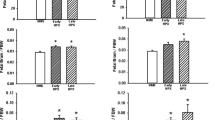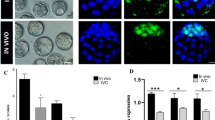Summary
Cytochrome oxidase, which is partially synthesized by the mitochondrion, was used as a measure for the development of mitochondrial function in rat embryos during the late stage of organogenesis. For this purpose the specific inhibitor of mitochondrial protein synthesis, chloramphenicol (CAP), served as a tool. Due to the rapid elimination rate of CAP from rats, a method for continuous infusion which would not cause immobilization to the animals was devised.
-
1.
Pharmacokinetic studies proved that CAP reaches the embryo before placentation. Concentrations of CAP in the embryo are as high as they are in the maternal serum (about 20 μg/ml serum or g embryo) and thus are sufficiently in supply for the inhibition of mitochondrial protein synthesis, if 1000 mg/kg CAP are infused intravenously per 24 hrs. CAP is partially excluded from the embryonic compartment after the placental barrier has fully developed: whereas CAP concentration in the maternal serum remains at about 20 μg/ml, the concentration in the embryonic compartment drops to about 10 μg/g embryonic tissue during day 13 of gestation.
-
2.
The average cytochrome oxidase activity per cell is very low (about 1 nmole O2 min×μg DNA−1) in embryonic tissue as it is in many other rapidly proliferating tissues. It is 15–60 times higher in slowly proliferating tissues, as, for example, the adult rat liver or brain (>14 nmoles O2/min×μg DNA−1).
-
3.
When the infusion technique is applied on day 12 of gestation, a sufficiently high concentration of CAP in embryonic tissue can be obtained to inhibit the synthesis of cytochrome oxidase. In contrast to tissues of an adult organism—as in the case of liver after partial hepatectomy—in embryonic tissues this limitation in the availability of cytochrome oxidase apparently results in a critical reduction of energy production, which subsequently affects DNA synthesis and embryonic growth.
-
4.
The possible relevance and applicability of these experimental findings to man is discussed.
Similar content being viewed by others
References
Alvin, J., Dixit, B. N.: Pharmacologic implications of alterations in the metabolism of chloramphenicol. Biochem. Pharmacol. 23, 139–151 (1974)
Barron, E. S. G., De Meio, R. H., Klemperer, F.: Studies on biological oxidations: V. Copper and hemochromogens as catalysts for the oxidation of ascorbic acid. J. biol. Chem. 112, 625–640 (1935/36)
Bartmann, K.: Antimikrobielle Chemotherapie. p. 138. Berlin-Heidelberg-New York: Springer 1974
Borei, H.: In: Ark. Kemi. Geol. 20 A, No. 8 (1945) quoted by Slater (1949)
Burton, K.: A study of the conditions and mechanism of the diphenylamine reaction for the colorimetric estimation of deoxyribonucleic acid. Biochem. J. 62, 315–323 (1956)
Chance, B., Schindler, F. J.: In: Oxidases and related redox systems: T. E. King, H. S. Mason, and M. Morrison, eds. New York: J. Wiley & Sons Inc. 1965
Cox, S. J., Gunberg, D. L.: Metabolite utilization by isolated embryonic rat hearts in vitro. J. Embryol. exp. Morph. 28, 235–245 (1972a)
Cox, S. J., Gunberg, D. L.: Energy metabolism in isolated rat embryo hearts: effect of metabolic inhibitors. J. Embryol. exp. Morph. 28, 591–599 (1972b)
Dutton, G. J.: Comparison of glucuronide synthesis in developing mammalian and avian liver. Ann. N.Y. Acad. Sci. 111, 259–273 (1963)
Ferrari, V., Della Bella, D.: Comparison of chloramphenicol and thiamphenicol metabolism. Postgrad. Med. 50, (Suppl. 5), 17–22 (1974)
Firkin, F. C., Linnane, A. W.: Biogenesis of mitochondria: 8. The effect of chloramphenicol on regenerating rat liver. Exp. Cell Res. 55, 68–76 (1969)
Fouts, J. R., Adamson, R. H.: Drug metabolism in the newborn rabbit. Science 129, 897–898 (1959)
Glazko, A. J., Dill, A. W.: Biochemical studies on chloramphenicol (chloromycetin): I. Colorimetric methods for the determination of chloramphenicol and related compounds. Arch. Biochem. 23, 411–418 (1949)
Jacovcic S., Haddock, J.: Getz, G. S., Rabinowitz, M., Swift, H.: Mitochondrial development in liver of foetal and newborn rats. Biochem. J. 121, 341–347 (1971)
Jäger, E., Bass, R.: Chloramphenicol thiamphenicol and cyclohexamide as tools for the measurement of mitochondrial protein synthesis in vitro during organogenesis of rat embryos. Naunyn-Schmiedeberg's Arch. Pharmacol. 290, 161–173 (1975)
Kroon, A. W.: Protein synthesis in mitochondria: III. On the effects of inhibitors on the incorporation of amino acids into protein by intact mitochondria and digitonin fractions. Biochem. biophys. Acta (Amst.) 108, 275–284 (1965)
Kroon, A. M., De Vries, H.: The effect of chloramphenicol on the biogenesis of mitochondria of rat liver in vivo. FEBS Leters 3, 208–210 (1969)
Lamb, A. J., Clark-Walker, G. D., Linnane, A. W.: The biogenesis of mitochondria: differentiation of mitochondrial and cytoplasmic protein synthesis in vitro by antibiotics. Biochem. biophys. Acta (Amst.) 161, 415–427 (1968)
Lehninger, A. L., Ul Hassan, M., Sudduth, H. C.: Phosphorylation coupled to the oxidation of ascorbic acid by mitochondria. J. biol. Chem. 210, 911–919 (1954)
Löbbecke, E. A., Schultze, B., Maurer, W.: Variabilität der Generationszeit bei fetalen Zellarten der Ratte. Exp. Cell Res. 55, 176–184 (1969)
Neubert, D., Gregg, C. T., Bass, R., Merker, H.-J.: Occurrence and possible functions of mitochondrial DNA in animal development. In: Biochemistry of animal development R. Weber, ed., Vol. III, pp. 387–464. New York: Academic Press 1975
Neubert, D., Oberdisse, E., Bass, R.: Biosynthesis and degradation of mammalian mitochondrial DNA. In: Biochemical aspects of the biogenesis of mitochondria, E. C. Slater, J. M. Tager, S. Papa, and E. Quagliariello, eds. pp. 103–128. Bari: Adriatica Editrice 1968
Neubert, D., Peters, H., Teske, S., Köhler, E., Barrach, H.-J.: Studies on the problem of “Aerobic Glycolysis” occurring in mammalian embryos. Naunyn-Schmiedebergs Arch. Pharmak. 268, 235–241 (1971)
Oerter, D., Bass, R.: Effect of chloramphenicol infusion on the rate of synthesis of cytochrome oxidase in mammalian embryonic tissue. Naunyn-Schmiedeberg's Arch. Pharmacol. 272, 239–242 (1972)
Roodyn, D. B., Wilkie, D.: The Biogenesis of mitochondria. pp. 38–39. London: Methuen 1968
Ross, S., Burke, F. G., Sites, J., Rice, E. C.: Placental transmission of chloramphenicol. J. Amer. med. Ass. 142, 1361–1362 (1950)
Rubin, M. S., Tzagoloff, A.: Assembly of the mitochondrial membrane system. X. Mitochondrial synthesis of three of the subunit proteins of yeast cytochrome oxidase. J. biol. Chem. 248, 4275–4279 (1973)
Schnaitman, C., Erwin, V. G., Greenawalt, I. W.: The submitochondrial localization of monoamine oxidase. An enzymatic marker for the outer membrane of rat liver mitochondria. J. Cell Biol. 32, 719–735 (1967)
Scott, W. C., Warner, R. F.: Placental transfer of chloramphenicol. J. Amer. med. Ass. 142, 1331–1332 (1950)
Slater, E. C.: The measurement of the cytochrome oxidase activity of enzyme preparations. Biochem. J. 44, 305–318 (1949)
Smith, L., Camerino, P. W.: Comparison of the polarographic and spectrometric assays for cytochrome-c-oxidase activity. Biochemistry 2, 1428–1432 (1963)
Uesugi, T., Ikeda, M., Kanei, Y., Hori, R., Arita, T.: Studies on the biliary excretion mechanisms of drugs; II. Biliary excretion of thiamphenicol, chloramphenicol and their glucuronides in the rat. Biochem. Pharmacol. 23, 2315–2321 (1971)
Vömel, W., Spingler, H.: Ein neuer geschmackfreier Chloramphenicolester (Chloramphenicol-3-stearoylglycolat). Arzneimittel-Forsch. 8, 123–126 (1959)
Walter, A. M., Heilmeyer, L.: Antibiotikafibel. p. 305. Stuttgart: Thieme 1969
Weiss, H., Sebald, W., Bücher, Th.: Cycloheximide resistant incorporation of amino acids into a polypeptide of the cytochrome oxidase of N. crassa. Europ. J. Biochem. 22, 19–26 (1971)
Wharton, D. C., Tzagoloff, A.: Cytochrome oxidase from beef heart mitochondria. In: Methods in Enzymology, Vol. X: Oxidation and Phosphorylation, R. W. Estabrook and M. E. Pullman, eds. pp. 245–250. New York: Academic Press 1967
Author information
Authors and Affiliations
Rights and permissions
About this article
Cite this article
Oerter, D., Bass, R. Embryonic development and mitochondrial function. Naunyn-Schmiedeberg's Arch. Pharmacol. 290, 175–189 (1975). https://doi.org/10.1007/BF00510549
Received:
Accepted:
Issue Date:
DOI: https://doi.org/10.1007/BF00510549




